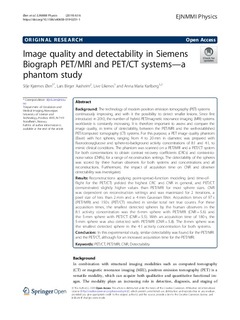| dc.description.abstract | Background
The technology of modern positron emission tomography (PET) systems continuously improving, and with it the possibility to detect smaller lesions. Since first introduced in 2010, the number of hybrid PET/magnetic resonance imaging (MRI) systems worldwide is constantly increasing. It is therefore important to assess and compare the image quality, in terms of detectability, between the PET/MRI and the well-established PET/computed tomography (CT) systems. For this purpose, a PET image quality phantom (Esser) with hot spheres, ranging from 4 to 20 mm in diameter, was prepared with fluorodeoxyglucose and sphere-to-background activity concentrations of 8:1 and 4:1, to mimic clinical conditions. The phantom was scanned on a PET/MRI and a PET/CT system for both concentrations to obtain contrast recovery coefficients (CRCs) and contrast-to-noise ratios (CNRs), for a range of reconstruction settings. The detectability of the spheres was scored by three human observers for both systems and concentrations and all reconstructions. Furthermore, the impact of acquisition time on CNR and observer detectability was investigated.
Results
Reconstructions applying point-spread-function modeling (and time-of-flight for the PET/CT) yielded the highest CRC and CNR in general, and PET/CT demonstrated slightly higher values than PET/MRI for most sphere sizes. CNR was dependent on reconstruction settings and was maximized for 2 iterations, a pixel size of less than 2 mm and a 4 mm Gaussian filter. Acquisition times of 97 s (PET/MRI) and 150 s (PET/CT) resulted in similar total net true counts. For these acquisition times, the smallest detected spheres by the human observers in the 8:1 activity concentration was the 6-mm sphere with PET/MRI (CNR = 5.6) and the 5-mm sphere with PET/CT (CNR = 5.5). With an acquisition time of 180 s, the 5-mm sphere was also detected with PET/MRI (CNR = 5.8). The 8-mm sphere was the smallest detected sphere in the 4:1 activity concentration for both systems.
Conclusion
In this experimental study, similar detectability was found for the PET/MRI and the PET/CT, although for an increased acquisition time for the PET/MRI. | nb_NO |

